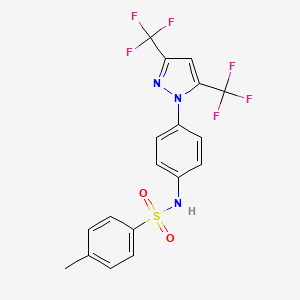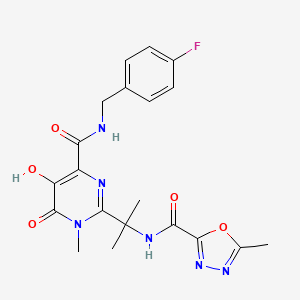
ラルテグラビル
概要
説明
ラルテグラビルは、ヒト免疫不全ウイルス(HIV)感染症の治療に他の薬剤と組み合わせて使用される抗レトロウイルス薬です。 ラルテグラビルは、承認された最初のHIVインテグラーゼ鎖転移阻害剤であり、ウイルス複製に必須の酵素であるHIVインテグラーゼの機能を阻害します 。 ラルテグラビルは2007年に米国で医療用として承認され、世界保健機関の必須医薬品リストに掲載されています .
製造方法
ラルテグラビルは、いくつかの重要な中間体を伴う複数段階のプロセスによって合成されます。合成における重要な課題の1つは、ピリミドン中間体の選択的なN-メチル化です。 合成経路は通常、以下の手順が含まれています :
N-アルキル化: ピリミドン中間体は、(クロロメチル)ジメチルクロロシランとフッ化カリウムを用いてアルキル化されます。
アミド化: アルキル化された中間体は、アミンとアミド化されます。
脱シリル化: 最終段階は、メタノール中のフッ化カリウムを用いて脱シリル化を行うことです。
工業的生産方法は、これらの手順を最適化して、高収率と純度を達成します。 このプロセスは、薬剤に使用される薬学的に活性な形態であるラルテグラビルカリウムを製造するために拡大されます .
作用機序
ラルテグラビルは、HIVインテグラーゼの触媒活性を阻害し、ウイルスのゲノムがヒトゲノムに統合されるのを防ぎます。この阻害は、ウイルス複製に不可欠なHIV-1統合の鎖転移段階を阻害します。 ラルテグラビルは、主にグルクロン酸抱合によって代謝されます .
類似化合物の比較
ラルテグラビルは、エルビテグラビル、ドルテグラビル、ビクテグラビル、カボテグラビルなどの他のインテグラーゼ鎖転移阻害剤(INSTI)と比較されます。 これらの化合物は、類似の作用機序を共有していますが、薬物動態学的および薬力学的特性が異なります :
エルビテグラビル: 効果的な血漿濃度には、コビシスタットによる増強が必要です。
ドルテグラビル: 耐性に対する高い障壁と1日1回の投与で知られています。
ビクテグラビル: エムトリシタビンとテノホビルアラフェナミドと併用して、単剤投与で配合されています。
カボテグラビル: 長期間持続性注射製剤として入手できます。
ラルテグラビルは、広範な安全性データと、薬剤耐性のあるHIVを持つ治療経験のある患者における使用においてユニークです .
科学的研究の応用
生化学分析
Biochemical Properties
Raltegravir plays a significant role in biochemical reactions as it inhibits HIV integrase, a key enzyme in the HIV life cycle . This enzyme is responsible for the integration of the HIV-1 viral DNA, generated by reverse transcription of the RNA genome, into the host cell chromosomes . By inhibiting this process, Raltegravir prevents the replication of the virus .
Cellular Effects
Raltegravir has a profound impact on various types of cells infected with HIV-1. By inhibiting the integrase enzyme, it prevents the integration of the viral DNA into the host cell chromosomes . This halts the production of new viruses, thereby influencing cell function and impacting cellular processes such as cell signaling pathways, gene expression, and cellular metabolism .
Molecular Mechanism
The molecular mechanism of Raltegravir involves the inhibition of the HIV integrase enzyme to prevent the viral genome from being incorporated into the human genome . Raltegravir is primarily metabolized by glucuronidation .
Temporal Effects in Laboratory Settings
In laboratory settings, Raltegravir has shown potent antiretroviral activity and is well tolerated in HIV-1–infected individuals . Specific resistance mutations have been identified in patients failing to respond to treatment with Raltegravir
Dosage Effects in Animal Models
In animal models, the effects of Raltegravir have been observed to vary with different dosages . More detailed studies are required to understand the threshold effects and any toxic or adverse effects at high doses.
Metabolic Pathways
Raltegravir is involved in metabolic pathways where it is primarily metabolized by glucuronidation . This metabolic process does not involve the liver, thus reducing the potential for drug-drug interactions .
Transport and Distribution
It is known that Raltegravir is approximately 83% bound to human plasma protein and is minimally distributed into red blood cells .
Subcellular Localization
Given its mechanism of action, it can be inferred that Raltegravir acts in the nucleus of the cell where it prevents the integration of the HIV-1 viral DNA into the host cell chromosomes .
準備方法
Raltegravir is synthesized through a multi-step process involving several key intermediates. One of the significant challenges in its synthesis is the selective N-methylation of a pyrimidone intermediate. The synthetic route typically involves the following steps :
N-alkylation: The pyrimidone intermediate is alkylated using (chloromethyl)dimethylchlorosilane and potassium fluoride.
Amidation: The alkylated intermediate undergoes amidation with an amine.
Desilylation: The final step involves desilylation using potassium fluoride in methanol.
Industrial production methods involve optimizing these steps to achieve high yields and purity. The process is scaled up to produce raltegravir potassium, which is the pharmaceutically active form used in medications .
化学反応の分析
ラルテグラビルは、以下を含むさまざまな化学反応を起こします。
酸化: ラルテグラビルは、特定の条件下で酸化されて、さまざまな酸化生成物を生成する可能性があります。
還元: ラルテグラビルの官能基を修飾するために、還元反応を実行できます。
置換: ラルテグラビルは、特にフルオロベンジル基で置換反応を起こす可能性があります。
これらの反応に使用される一般的な試薬には、過酸化水素などの酸化剤、水素化ホウ素ナトリウムなどの還元剤、置換反応のための求核剤などがあります。 形成される主な生成物は、使用される特定の反応条件と試薬によって異なります .
科学研究への応用
ラルテグラビルは、以下を含むいくつかの科学研究への応用があります。
医学: ラルテグラビルは、主にHIV-1感染症の治療に使用されます。
生物学: ラルテグラビルは、HIVの統合と複製メカニズムを研究するために研究に使用されます。
化学: ラルテグラビルの合成と化学的性質は、新しいインテグラーゼ阻害剤を開発し、既存のインテグラーゼ阻害剤を改善するために研究されています.
産業: ラルテグラビルは、医薬品用途のために工業規模で生産されており、その生産方法は、効率性と費用対効果の観点から継続的に最適化されています.
類似化合物との比較
Raltegravir is compared with other integrase strand transfer inhibitors (INSTIs) such as elvitegravir, dolutegravir, bictegravir, and cabotegravir. These compounds share a similar mechanism of action but differ in their pharmacokinetic and pharmacodynamic properties :
Elvitegravir: Requires boosting with cobicistat for effective plasma levels.
Dolutegravir: Known for its high barrier to resistance and once-daily dosing.
Bictegravir: Co-formulated with emtricitabine and tenofovir alafenamide in a single-tablet regimen.
Cabotegravir: Available as a long-acting injectable formulation.
Raltegravir is unique in its extensive safety data and its use in treatment-experienced patients with drug-resistant HIV .
特性
IUPAC Name |
N-[2-[4-[(4-fluorophenyl)methylcarbamoyl]-5-hydroxy-1-methyl-6-oxopyrimidin-2-yl]propan-2-yl]-5-methyl-1,3,4-oxadiazole-2-carboxamide | |
|---|---|---|
| Source | PubChem | |
| URL | https://pubchem.ncbi.nlm.nih.gov | |
| Description | Data deposited in or computed by PubChem | |
InChI |
InChI=1S/C20H21FN6O5/c1-10-25-26-17(32-10)16(30)24-20(2,3)19-23-13(14(28)18(31)27(19)4)15(29)22-9-11-5-7-12(21)8-6-11/h5-8,28H,9H2,1-4H3,(H,22,29)(H,24,30) | |
| Source | PubChem | |
| URL | https://pubchem.ncbi.nlm.nih.gov | |
| Description | Data deposited in or computed by PubChem | |
InChI Key |
CZFFBEXEKNGXKS-UHFFFAOYSA-N | |
| Source | PubChem | |
| URL | https://pubchem.ncbi.nlm.nih.gov | |
| Description | Data deposited in or computed by PubChem | |
Canonical SMILES |
CC1=NN=C(O1)C(=O)NC(C)(C)C2=NC(=C(C(=O)N2C)O)C(=O)NCC3=CC=C(C=C3)F | |
| Source | PubChem | |
| URL | https://pubchem.ncbi.nlm.nih.gov | |
| Description | Data deposited in or computed by PubChem | |
Molecular Formula |
C20H21FN6O5 | |
| Source | PubChem | |
| URL | https://pubchem.ncbi.nlm.nih.gov | |
| Description | Data deposited in or computed by PubChem | |
DSSTOX Substance ID |
DTXSID2048660 | |
| Record name | Raltegravir | |
| Source | EPA DSSTox | |
| URL | https://comptox.epa.gov/dashboard/DTXSID2048660 | |
| Description | DSSTox provides a high quality public chemistry resource for supporting improved predictive toxicology. | |
Molecular Weight |
444.4 g/mol | |
| Source | PubChem | |
| URL | https://pubchem.ncbi.nlm.nih.gov | |
| Description | Data deposited in or computed by PubChem | |
Mechanism of Action |
Raltegravir inhibits HIV integrase to prevent the viral genome being incorporated into the human genome. Raltegravir is primarily metabolized by glucuronidation., Raltegravir inhibits the catalytic activity of HIV-1 integrase, an HIV-1 encoded enzyme that is required for viral replication. Inhibition of integrase prevents the covalent insertion, or integration, of unintegrated linear HIV-1 DNA into the host cell genome preventing the formation of the HIV-1 provirus. The provirus is required to direct the production of progeny virus, so inhibiting integration prevents propagation of the viral infection. Raltegravir did not significantly inhibit human phosphoryltransferases including DNA polymerases alpha, beta, and gamma. | |
| Record name | Raltegravir | |
| Source | DrugBank | |
| URL | https://www.drugbank.ca/drugs/DB06817 | |
| Description | The DrugBank database is a unique bioinformatics and cheminformatics resource that combines detailed drug (i.e. chemical, pharmacological and pharmaceutical) data with comprehensive drug target (i.e. sequence, structure, and pathway) information. | |
| Explanation | Creative Common's Attribution-NonCommercial 4.0 International License (http://creativecommons.org/licenses/by-nc/4.0/legalcode) | |
| Record name | Raltegravir | |
| Source | Hazardous Substances Data Bank (HSDB) | |
| URL | https://pubchem.ncbi.nlm.nih.gov/source/hsdb/8124 | |
| Description | The Hazardous Substances Data Bank (HSDB) is a toxicology database that focuses on the toxicology of potentially hazardous chemicals. It provides information on human exposure, industrial hygiene, emergency handling procedures, environmental fate, regulatory requirements, nanomaterials, and related areas. The information in HSDB has been assessed by a Scientific Review Panel. | |
CAS No. |
518048-05-0 | |
| Record name | Raltegravir | |
| Source | CAS Common Chemistry | |
| URL | https://commonchemistry.cas.org/detail?cas_rn=518048-05-0 | |
| Description | CAS Common Chemistry is an open community resource for accessing chemical information. Nearly 500,000 chemical substances from CAS REGISTRY cover areas of community interest, including common and frequently regulated chemicals, and those relevant to high school and undergraduate chemistry classes. This chemical information, curated by our expert scientists, is provided in alignment with our mission as a division of the American Chemical Society. | |
| Explanation | The data from CAS Common Chemistry is provided under a CC-BY-NC 4.0 license, unless otherwise stated. | |
| Record name | Raltegravir [USAN:INN] | |
| Source | ChemIDplus | |
| URL | https://pubchem.ncbi.nlm.nih.gov/substance/?source=chemidplus&sourceid=0518048050 | |
| Description | ChemIDplus is a free, web search system that provides access to the structure and nomenclature authority files used for the identification of chemical substances cited in National Library of Medicine (NLM) databases, including the TOXNET system. | |
| Record name | Raltegravir | |
| Source | DrugBank | |
| URL | https://www.drugbank.ca/drugs/DB06817 | |
| Description | The DrugBank database is a unique bioinformatics and cheminformatics resource that combines detailed drug (i.e. chemical, pharmacological and pharmaceutical) data with comprehensive drug target (i.e. sequence, structure, and pathway) information. | |
| Explanation | Creative Common's Attribution-NonCommercial 4.0 International License (http://creativecommons.org/licenses/by-nc/4.0/legalcode) | |
| Record name | Raltegravir | |
| Source | EPA DSSTox | |
| URL | https://comptox.epa.gov/dashboard/DTXSID2048660 | |
| Description | DSSTox provides a high quality public chemistry resource for supporting improved predictive toxicology. | |
| Record name | N-[(4-fluorophenyl)methyl]-1,6-dihydro-5-hydroxy-1-methyl-2-[1-methyl-1-[[(5-methyl-1,3,4-oxadiazol-2-yl)carbonyl]amino]ethyl]-6-oxo-4-pyrimidinecarboxamide | |
| Source | European Chemicals Agency (ECHA) | |
| URL | https://echa.europa.eu/substance-information/-/substanceinfo/100.124.631 | |
| Description | The European Chemicals Agency (ECHA) is an agency of the European Union which is the driving force among regulatory authorities in implementing the EU's groundbreaking chemicals legislation for the benefit of human health and the environment as well as for innovation and competitiveness. | |
| Explanation | Use of the information, documents and data from the ECHA website is subject to the terms and conditions of this Legal Notice, and subject to other binding limitations provided for under applicable law, the information, documents and data made available on the ECHA website may be reproduced, distributed and/or used, totally or in part, for non-commercial purposes provided that ECHA is acknowledged as the source: "Source: European Chemicals Agency, http://echa.europa.eu/". Such acknowledgement must be included in each copy of the material. ECHA permits and encourages organisations and individuals to create links to the ECHA website under the following cumulative conditions: Links can only be made to webpages that provide a link to the Legal Notice page. | |
| Record name | RALTEGRAVIR | |
| Source | FDA Global Substance Registration System (GSRS) | |
| URL | https://gsrs.ncats.nih.gov/ginas/app/beta/substances/22VKV8053U | |
| Description | The FDA Global Substance Registration System (GSRS) enables the efficient and accurate exchange of information on what substances are in regulated products. Instead of relying on names, which vary across regulatory domains, countries, and regions, the GSRS knowledge base makes it possible for substances to be defined by standardized, scientific descriptions. | |
| Explanation | Unless otherwise noted, the contents of the FDA website (www.fda.gov), both text and graphics, are not copyrighted. They are in the public domain and may be republished, reprinted and otherwise used freely by anyone without the need to obtain permission from FDA. Credit to the U.S. Food and Drug Administration as the source is appreciated but not required. | |
| Record name | Raltegravir | |
| Source | Hazardous Substances Data Bank (HSDB) | |
| URL | https://pubchem.ncbi.nlm.nih.gov/source/hsdb/8124 | |
| Description | The Hazardous Substances Data Bank (HSDB) is a toxicology database that focuses on the toxicology of potentially hazardous chemicals. It provides information on human exposure, industrial hygiene, emergency handling procedures, environmental fate, regulatory requirements, nanomaterials, and related areas. The information in HSDB has been assessed by a Scientific Review Panel. | |
Synthesis routes and methods
Procedure details





Q1: How does Raltegravir exert its antiretroviral effect?
A1: Raltegravir is a potent inhibitor of HIV-1 integrase, specifically targeting the strand transfer step of the viral integration process. [] This prevents the integration of the viral genome into the host cell's DNA, a crucial step for viral replication. [, ]
Q2: What is the consequence of inhibiting HIV-1 integrase?
A2: Blocking the strand transfer step by Raltegravir leads to the accumulation of unintegrated viral DNA in the cytoplasm of infected cells. [, ] This ultimately prevents the production of new infectious viral particles, effectively suppressing viral replication. [, , ]
Q3: What is the significance of Raltegravir's target in the HIV life cycle?
A3: HIV-1 integrase is a viral enzyme essential for viral replication and is not found in human cells. [] Targeting this unique enzyme offers a high degree of selectivity, minimizing the potential for adverse effects on host cell processes. []
Q4: What is the molecular formula and weight of Raltegravir?
A4: This information is not provided in the provided scientific papers. Please consult comprehensive chemical databases like PubChem or DrugBank for detailed structural information.
Q5: How stable is Raltegravir under various storage conditions?
A5: While the provided research doesn't specify exact storage conditions, one study mentions that high-performance liquid chromatography (HPLC) was used to measure Raltegravir trough concentrations, suggesting it maintains stability in biological samples for analysis. [] Further research on its stability under different environmental conditions (temperature, humidity, light) would be valuable.
Q6: Does Raltegravir exhibit any catalytic activity itself?
A6: No, Raltegravir is an enzyme inhibitor. It acts by binding to HIV-1 integrase and blocking its catalytic activity, specifically the strand transfer reaction required for integrating viral DNA into the host cell genome. [, ]
Q7: Have any computational studies been conducted on Raltegravir?
A7: Yes, one study used an in vitro-in vivo extrapolation model to predict Raltegravir pharmacokinetics in virtual individuals with different gastrointestinal pH profiles. [] This model successfully predicted key pharmacokinetic variables with good accuracy compared to clinical data, demonstrating the utility of computational approaches in understanding Raltegravir disposition. []
Q8: How do structural modifications of Raltegravir affect its activity?
A8: The provided research focuses primarily on Raltegravir's clinical efficacy and resistance mutations rather than exploring detailed SAR. Investigating the impact of structural changes on Raltegravir's binding affinity, inhibitory potency, and resistance profile would be an interesting avenue for future research.
Q9: What is the primary route of Raltegravir elimination in humans?
A10: Raltegravir is primarily eliminated via metabolism, specifically through glucuronidation by the enzyme UGT1A1. [] This process leads to the formation of Raltegravir glucuronide, the major metabolite, which is then excreted in urine and feces. []
Q10: Does food intake affect Raltegravir pharmacokinetics?
A11: Yes, a study investigating the effect of different meal types on Raltegravir's pharmacokinetic profile found that high-fat meals might influence the drug's absorption and distribution without affecting overall exposure. [] This highlights the importance of understanding food-drug interactions for optimizing Raltegravir therapy.
Q11: How do Raltegravir concentrations vary across different biological compartments?
A12: Research indicates that Raltegravir concentrations can vary significantly between plasma, intracellular compartments (like peripheral blood mononuclear cells), and tissues (such as cervical tissue). [, ] These differences highlight the need to consider tissue-specific drug distribution when evaluating Raltegravir's efficacy and potential for pre-exposure prophylaxis (PrEP). []
Q12: What factors contribute to the high inter-individual variability observed in Raltegravir pharmacokinetics?
A12: Several factors can contribute to variability in Raltegravir's pharmacokinetic profile, including:
- Genetic polymorphisms: Variations in the UGT1A1 gene, particularly the UGT1A16 and 28 alleles, may impact Raltegravir metabolism and clearance. []
- Gastrointestinal factors: Luminal pH and the presence of divalent metals, like magnesium, can influence Raltegravir absorption. [, ]
- Co-administered medications: Drug-drug interactions with medications metabolized by UGT1A1 or those altering gastrointestinal pH can alter Raltegravir exposure. [, , , ]
- Liver transplantation: Patients who have undergone liver transplantation may experience reduced Raltegravir clearance, potentially leading to higher drug exposure. []
Q13: What is the significance of Raltegravir trough concentrations?
A14: Raltegravir's virologic efficacy is best correlated with its trough concentration (C trough). [] Maintaining C trough levels above the 95% inhibitory concentration (IC95) is crucial for achieving optimal viral suppression. [, ]
Q14: How is Raltegravir's efficacy assessed in preclinical settings?
A15: Cell-based assays using TZM-bl indicator cells are used to evaluate Raltegravir's ability to inhibit HIV infection in vitro. [] Additionally, humanized mouse models, such as the humanized BLT (bone marrow-liver-thymus) mice, are valuable tools for studying Raltegravir's antiviral activity, pharmacokinetics, and efficacy in preventing vaginal HIV transmission in vivo. []
Q15: Has Raltegravir's efficacy been demonstrated in clinical trials?
A16: Yes, numerous clinical trials have established the potent and durable antiretroviral activity of Raltegravir in both treatment-naive and treatment-experienced HIV-1-infected patients. [, , , , , , ] When combined with tenofovir/emtricitabine, Raltegravir achieves viral suppression and immune restoration comparable to efavirenz-based regimens. [, ] Moreover, Raltegravir has shown effectiveness in salvage therapy for patients with multidrug-resistant HIV-1 infection. [, , , ]
Q16: What are the primary mechanisms of resistance to Raltegravir?
A17: Resistance to Raltegravir typically arises from mutations in the HIV-1 integrase gene. [, , , ] The most common mutations associated with Raltegravir resistance cluster around three main pathways:
Q17: Does cross-resistance exist between Raltegravir and other integrase inhibitors?
A18: Yes, cross-resistance can occur between Raltegravir and other integrase strand transfer inhibitors (INSTIs), such as elvitegravir and dolutegravir. [, , ] The extent of cross-resistance depends on the specific mutations present in the HIV-1 integrase gene. [, , ] For instance, mutations in the Q148 pathway often confer a higher level of resistance to Raltegravir and elvitegravir compared to dolutegravir. [, ]
Q18: Can Raltegravir resistance impact subsequent treatment options?
A19: Yes, the emergence of Raltegravir resistance mutations can limit future treatment options, particularly with other INSTIs. [, ] Therefore, it's crucial to monitor for resistance development and consider alternative antiretroviral agents when appropriate.
Q19: Does Raltegravir retain any antiviral activity against resistant HIV-1 strains?
A20: Studies suggest that Raltegravir might have limited to no residual antiviral activity against HIV-1 strains harboring major resistance mutations. [, ] This finding raises questions about the benefit of maintaining Raltegravir in salvage regimens for patients with documented resistance. []
試験管内研究製品の免責事項と情報
BenchChemで提示されるすべての記事および製品情報は、情報提供を目的としています。BenchChemで購入可能な製品は、生体外研究のために特別に設計されています。生体外研究は、ラテン語の "in glass" に由来し、生物体の外で行われる実験を指します。これらの製品は医薬品または薬として分類されておらず、FDAから任何の医療状態、病気、または疾患の予防、治療、または治癒のために承認されていません。これらの製品を人間または動物に体内に導入する形態は、法律により厳格に禁止されています。これらのガイドラインに従うことは、研究と実験において法的および倫理的な基準の遵守を確実にするために重要です。
![3-Pyridinesulfonamide, 6-[3-cyano-6-ethyl-5-fluoro-1-(2-pyrimidinyl)-1H-indol-2-yl]-N-[(1S)-2,2,2-trifluoro-1-methylethyl]-](/img/structure/B610331.png)
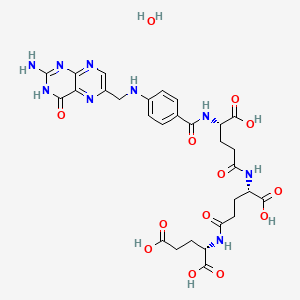
![Methyl 3-[[4-(tert-butylamino)-2-methoxyphenyl]sulfamoyl]thiophene-2-carboxylate](/img/structure/B610334.png)

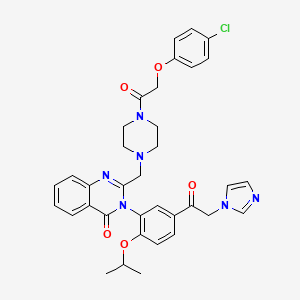
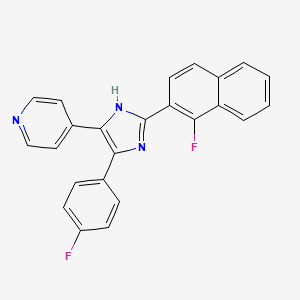

![1-[(Z)-4-amino-2-fluorobut-2-enyl]-3-[3-(dimethylsulfamoyl)phenyl]-2-methylindole-5-carboxylic acid;hydrochloride](/img/structure/B610345.png)
![methyl 4-[3-acetyl-4-hydroxy-1-[2-(2-methyl-1H-indol-3-yl)ethyl]-5-oxo-2H-pyrrol-2-yl]benzoate](/img/structure/B610347.png)
